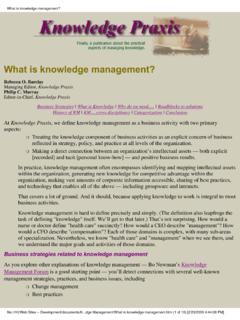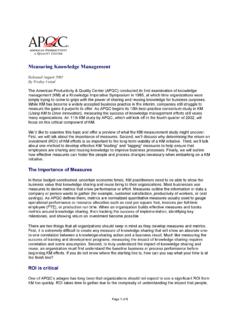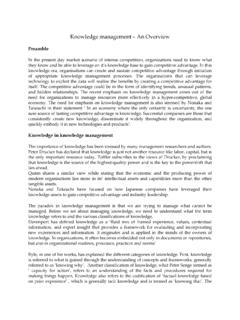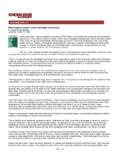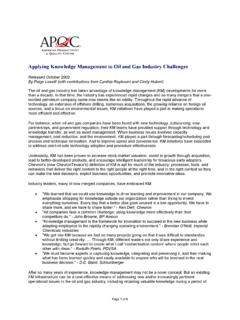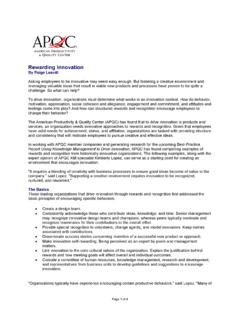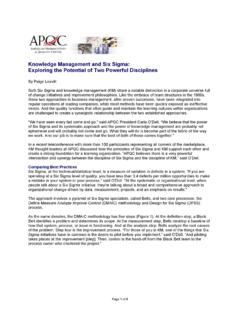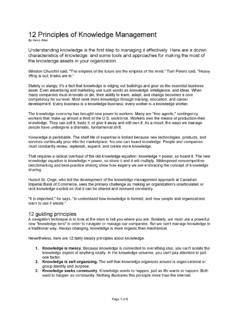Transcription of Successfully Implementing Knowledge Management
1 AMERICAN PRODUCTIVITY & QUALITY CENTER123 NORTH POST OAK LANE, HOUSTON, TEXAS 77024-7797 713-681-4020 2000 AMERICAN PRODUCTIVITY & QUALITY CENTER. ALL RIGHTS ImplementingKnowledge ManagementAPQCINTERNATIONALBENCHMARKINGC LEARINGHOUSECONSORTIUM LEARNING FORUMBEST-PRACTICE REPORTMEMBERSHIP INFORMATIONFor information about how to become a member of the International Benchmarking Clearinghouse,a service of the American Productivity & Quality Center (APQC), and receive publications and otherbenefits, call 800-776-9676 or 713-681-4020 or visit our Web site at 2000 American Productivity & Quality Center, 123 North Post Oak Lane, Third Floor, Houston, Texas77024-7797. This report cannot be reproduced or transmitted in any form or by any means electronicor mechanical, including photocopying, faxing, recording, or information storage and copies of this report may be purchased from the APQC Order Department at 800-776-9676 ( ) or 713-681-4020.
2 Quantity discounts are 1-928593-32-1 STATEMENT OF PURPOSEThe purpose of publishing this report is to provide a reference point for and insight into the processes andpractices associated with certain issues. It should be used as an educational learning tool and is not a recipe or step-by-step procedure to be copied or duplicated in any way. This report may not represent current orga-nizational processes, policies, or practices because changes may have occurred since the completion of the Implementing Knowledge Management 2000 APQC2 Knowledge MANAGEMENTP roject PersonnelProject TeamKimberly LopezFarida HasanaliAmerican Productivity & Quality CenterSubject Matter ExpertsCarla O Dell, , PresidentCindy Hubert, Senior Knowledge Management ConsultantPeggy Odem, Senior Knowledge Management ConsultantAmerican Productivity & Quality CenterSpecial AdviserCynthia RaybournContributing AuthorsFarida Hasanali, Cindy Hubert, Kimberly Lopez,Carla O Dell, Peggy Odem, Cynthia RaybournEditorCraig HendersonDesignersConnie Choate, Victoria Wirz.
3 Fred Bobovnyk3 Successfully Implementing Knowledge Management 2000 APQCKNOWLEDGE MANAGEMENTC ontents of Study Report4 Sponsor and PartnerOrganizationsA listing of the sponsor organizations in thisstudy, as well as the best-practice ( partner )organizations that were benchmarked for theirinnovation and advancement in SummaryA bird s-eye view of the study, presenting thekey findings discovered and the methodologyused throughout the course of the study. Thefindings are explored in detail in FindingsAn in-depth look at the findings of this findings are supported by quantitativedata and qualitative examples of practicesemployed by the partner OrganizationCase StudiesBackground information on the partnerorganizations, as well as details about theirinnovative Knowledge Management OrganizationsKNOWLEDGE MANAGEMENTS uccessfully Implementing Knowledge Management 2000 APQCA nadarko Petroleum CorporationBest BuyBHPB oehringer IngelheimChase Manhattan BankCorning & CompanyDetroit Diesel CorporationDow Corning Chemical CompanyEquilon Pipeline Company LLCG eorgia Power CompanyGlaxoWellcomeHewlett-PackardIBM Global FoodsLockheed MartinMaytag CorporationMitre OrganizationNational Defense UniversityNational Security AgencyNaval Undersea Warfare DivisionPension Benefit Guaranty CorporationPDVSA ProductionPremier DiagnosticsSchlumberger LimitedSiemens Medical SystemsSmithKline BeechamSprintTexaco Department of Veterans AffairsUnited Parcel CorporationXerox Corporation5 Partner OrganizationsSuccessfully
4 Implementing Knowledge Management 2000 APQCKNOWLEDGE Management *Buckman Laboratories InternationalChevron Corporation*Gateway ComputersHewlett-Packard Consulting*IBM Global Services*Nortel Networks*RaytheonSiemens AGThe World BankXerox Corporation*Represented in quantitative data onlySuccessfully Implementing Knowledge Management 2000 APQC6 Executive Summaryhis Best-Practice Report is based on a Knowledge Management (KM) con-sortium benchmarking study conducted by the International BenchmarkingClearinghouse, a service of the American Productivity & Quality Center(APQC). Previous consortium studies include: Creating a Knowledge -Sharing Culture, Expanding Knowledge Management Externally: Putting Your Knowledge to Workfor Customers, Knowledge Management and the Learning Organisation: A European Perspective, Managing Competitive Intelligence Knowledge in a Global Economy.
5 EmergingBest Practices in Knowledge Management , and Using Information Technology to Support Knowledge on its successful predecessors, this study focuses on how some of themost advanced early KM adopters implement a Knowledge Management initiative, mobi-lize resources, create a business case, and measure and evolve their KM goal of this report is to enable organizations to compare their own knowledgemanagement initiatives with others and identify any performance gaps or opportunitiesfor improvement. This Best-Practice Report also affords them the opportunity togain a better understanding of issues faced and challenges overcome in implementinga successful Knowledge Management initiative. Forty-nine companies participated in this consortium by attending a series ofplanning sessions, completing data-gathering surveys, and/or attending or hostingon-site interviews.
6 Of those 49 companies, 39 sponsored the study ( sponsor companies ).Ten companies, including two of the sponsor companies, were identified as having strongknowledge Management initiatives in place and were invited to participate in thestudy as benchmarking partners ( partner companies ).Since APQC s research and benchmarking activities began five years ago, someof the early adopters of KM, including the best-practice organizations for this study,have been able to address many of the issues that arise with any new way of doing busi-ness. Their experiences address the typical business questions that any senior exec-utive would ask about a new initiative, such as why should we do this ( , What isthe business case?), who is going to be responsible ( , What roles and resources arenecessary?), and how will we know if it makes a difference ( , How do you mea-TKNOWLEDGE MANAGEMENT7 Successfully Implementing Knowledge Management 2000 APQC sure the results?)
7 We ve turned to the early adopters and best-practice organizationsto understand the critical success factors, options, and steps needed to implement a suc-cessful Knowledge Management initiative. STUDY FOCUSD rawing input from subject matter expert (SME) Dr. Carla O Dell and APQC research, the APQC study team identified four key focus areas. These areas guided thedesign of the data collection instruments and were the basis on which the stages ofsuccessful implementation have been developed. A brief description of the four areasis provided Creating a KM Business Case Building the business case for KM Justifying and gaining Management support for the KM budget Developing a value proposition for KM that s tied to the business strategy2. Structuring a KM Strategy Aligning KM with business strategy Leadership and support needed to sustain a KM strategy3.
8 Implementing Your KM Initiative The advantages of a top-down or a bottom-up approach to KM Technologies to support KM Leveraging intranets to share and capture Knowledge internally The roles organizations are creating to support KM strategies Determining staff size and how much time and resources to spend on KM The role of KM training 4. Measuring and Evolving the KM Efforts Soliciting feedback regarding KM products Evaluating the effectiveness of KM programs Understanding how and why KM programs evolve Developing global KM capabilitiesREPORT OVERVIEWT here is widespread understanding of the value of Knowledge Management inmany organizations. One might think that mature Knowledge Management initia-tives are widespread as well. In fact, the gap between organizations recognizing the valueof Knowledge Management and those fully Implementing it is large.
9 As evidence, at theinception of this consortium study, more than 80 percent of the organizations in thesponsor group indicated that they have no formal plan or are just beginning our sponsor group behind the times? Hardly. They represent many forward-looking organizations exploring and piloting KM. Only our Knowledge manage-SUMMARYS uccessfully Implementing Knowledge Management 2000 APQC8ment early adopters are far along the implementation journey. This study s focus is tounderstand how the Knowledge Management initiatives in best-practice companiesstarted and evolved, not to get a snapshot of where they are now. By understanding theprocess, and stages, practitioners will be better equipped to manage Knowledge intheir own has created a model that captures the stages of Successfully implementingknowledge Management .
10 This emergent model, illustrated in later sections, was devel-oped using data from all of the best-practice companies, as well as APQC s experi-ences with many of the early adopters of described in the model overview chapter, the model provides us a framework todiscuss the typical stages and characteristics; the model is not rigid, but fluid. Knowledgemanagement implementation stages can serve as a road map to enable the reader to under-stand where his/her organization is in the KM journey, to see how others have suc-cessfully faced the same challenges, and to know what might be done to move the issues and knowing the tools and tactics of others can help at anystage. Learning from others is the opportunity to make new mistakes, not repeat thoseof following provides a brief overview of some of the key features of successful imple-mentation discovered during this Cases and BudgetsIn every successful large-scale KM initiative we have examined, including those inthis study, an important senior champion or group saw the strategic value of knowledgemanagement and endorsed what became a significant investment in it.
